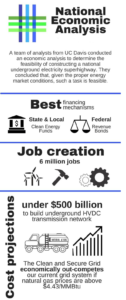
 A team of analysts from University of California – Davis conducted economic and financial analyses to determine the financial and economic feasibility of implementing the North American Supergrid (NAS). To deduce financing mechanisms for an infrastructure initiative of this magnitude, the team performed several case studies by building upon a previous analysis conducted by Carnegie Mellon. They concluded that the financial feasibility of the system is inherently structured around the building of the most lucrative system lines first. Revenue bonds allow private capital to finance the initiative on the federal level, while smaller lines may take advantage of state Clean Energy Funds. In either case, the NAS will not require new public funding schemes or new taxes to garner capital. Instead, rate payers will produce returns through electric bill fees. Such investment will enable the creation of an estimated 6 million jobs nationwide in many economic sectors. These jobs will not only be generated from the construction of the transmission system, but will also originate from the construction and operation of new (mostly renewable) electricity generation facilities throughout the United States. Overall, this infrastructure package will cost between $303 billion and $442 billion dollars to build the transmission system (depending on the additional cost of cable burial), as well as an additional $2.2 trillion dollars to construct additional electricity generation facilities. Despite these costs, it is crucial to note that consumer electric bills will not increase as a result. Additionally, although configuring HVDC lines underground often costs three – five times that of above ground lines, this study indicates that this costlier configuration is still an economically viable solution; an underground HVDC system (that is three times more expensive than above ground lines) will cost less than continuing the operation of the nation’s current grid system given that the cost of natural gas remains above $4.43/MMBtu. According to EIA, the cost of natural gas is set to increase to at least $5/MMBtu by 2030, meaning that the NAS is forecasted to be a viable economic solution by its time of completion.
A team of analysts from University of California – Davis conducted economic and financial analyses to determine the financial and economic feasibility of implementing the North American Supergrid (NAS). To deduce financing mechanisms for an infrastructure initiative of this magnitude, the team performed several case studies by building upon a previous analysis conducted by Carnegie Mellon. They concluded that the financial feasibility of the system is inherently structured around the building of the most lucrative system lines first. Revenue bonds allow private capital to finance the initiative on the federal level, while smaller lines may take advantage of state Clean Energy Funds. In either case, the NAS will not require new public funding schemes or new taxes to garner capital. Instead, rate payers will produce returns through electric bill fees. Such investment will enable the creation of an estimated 6 million jobs nationwide in many economic sectors. These jobs will not only be generated from the construction of the transmission system, but will also originate from the construction and operation of new (mostly renewable) electricity generation facilities throughout the United States. Overall, this infrastructure package will cost between $303 billion and $442 billion dollars to build the transmission system (depending on the additional cost of cable burial), as well as an additional $2.2 trillion dollars to construct additional electricity generation facilities. Despite these costs, it is crucial to note that consumer electric bills will not increase as a result. Additionally, although configuring HVDC lines underground often costs three – five times that of above ground lines, this study indicates that this costlier configuration is still an economically viable solution; an underground HVDC system (that is three times more expensive than above ground lines) will cost less than continuing the operation of the nation’s current grid system given that the cost of natural gas remains above $4.43/MMBtu. According to EIA, the cost of natural gas is set to increase to at least $5/MMBtu by 2030, meaning that the NAS is forecasted to be a viable economic solution by its time of completion.
